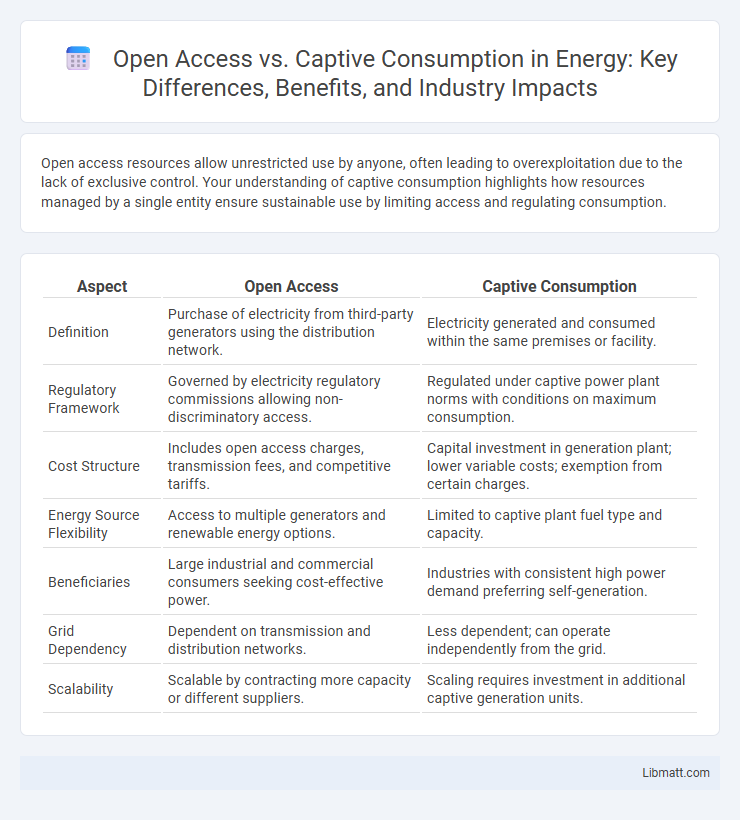Open access resources allow unrestricted use by anyone, often leading to overexploitation due to the lack of exclusive control. Your understanding of captive consumption highlights how resources managed by a single entity ensure sustainable use by limiting access and regulating consumption.
Table of Comparison
| Aspect | Open Access | Captive Consumption |
|---|---|---|
| Definition | Purchase of electricity from third-party generators using the distribution network. | Electricity generated and consumed within the same premises or facility. |
| Regulatory Framework | Governed by electricity regulatory commissions allowing non-discriminatory access. | Regulated under captive power plant norms with conditions on maximum consumption. |
| Cost Structure | Includes open access charges, transmission fees, and competitive tariffs. | Capital investment in generation plant; lower variable costs; exemption from certain charges. |
| Energy Source Flexibility | Access to multiple generators and renewable energy options. | Limited to captive plant fuel type and capacity. |
| Beneficiaries | Large industrial and commercial consumers seeking cost-effective power. | Industries with consistent high power demand preferring self-generation. |
| Grid Dependency | Dependent on transmission and distribution networks. | Less dependent; can operate independently from the grid. |
| Scalability | Scalable by contracting more capacity or different suppliers. | Scaling requires investment in additional captive generation units. |
Introduction to Open Access and Captive Consumption
Open Access refers to a model where resources, such as data or infrastructure, are made freely available to all users without restrictions, promoting innovation and broad usage. Captive Consumption, in contrast, limits access to resources exclusively to a specific group or organization, ensuring controlled use and maximized internal benefits. Understanding the distinctions between these models helps you decide how to balance openness with control in resource management strategies.
Defining Open Access: Key Concepts
Open Access refers to the unrestricted availability of resources or services, allowing You to freely access, use, and share content without barriers like subscriptions or exclusive permissions. Key concepts include transparency, inclusivity, and user empowerment, promoting equitable distribution of knowledge and services. In contrast, Captive Consumption limits access to resources within a controlled environment, restricting use to specific audiences or conditions.
Understanding Captive Consumption
Captive consumption occurs when consumers are restricted to using a specific product or service offered by a single supplier, limiting their ability to switch to alternatives. This model often results in higher prices and reduced consumer choice due to dependency on the captive provider. Your understanding of captive consumption is crucial to recognizing market power and potential inefficiencies in sectors where options are deliberately constrained.
Regulatory Framework Governing Both Models
The regulatory framework governing open access and captive consumption models centers on ensuring fair grid usage and promoting efficient energy distribution. Open access regulations mandate transparent, non-discriminatory terms for third-party consumers to access transmission and distribution networks, fostering competition and renewable integration. In contrast, captive consumption is typically regulated by policies restricting consumers to designated sources, with tariffs and compliance norms aimed at safeguarding the captive consumer's interests within the limits of the grid owner's control.
Advantages of Open Access in Power Systems
Open Access in power systems enhances competition by allowing multiple electricity producers to use the same transmission network, leading to more efficient market operations and reduced electricity prices. It promotes transparency and consumer choice, empowering consumers to select from various providers based on price and service quality. Open Access also encourages investment in renewable energy by facilitating grid access for independent power producers, supporting sustainable energy integration.
Benefits and Limitations of Captive Consumption
Captive consumption ensures dedicated resource availability and reliable energy supply by restricting use to a specific consumer or group, enhancing control over operational costs and demand management. However, it limits flexibility and market competition, potentially leading to higher expenses and less innovation compared to open access systems. Your choice of captive consumption may benefit from stable pricing but should consider the trade-off in reduced energy sourcing options.
Cost Implications for Consumers and Producers
Open Access models minimize upfront costs for consumers by allowing free or low-cost access to content, shifting financial burdens primarily onto producers through publication fees or funding requirements. Captive Consumption often entails subscription or licensing fees, increasing direct expenses for consumers while providing producers with steady, predictable revenue streams. Both models impact market dynamics differently, influencing affordability, accessibility, and investment incentives within the content distribution ecosystem.
Environmental Impact Assessment
Environmental Impact Assessment (EIA) plays a crucial role in comparing Open Access and Captive Consumption energy models by analyzing ecological footprints, emission levels, and resource utilization. Open Access typically promotes renewable energy integration, potentially reducing carbon emissions and supporting sustainable development goals. Your choice between these models directly influences environmental outcomes and compliance with regulatory frameworks governing ecological conservation.
Challenges and Risks in Implementation
Implementing open access in industries like energy and telecommunications faces challenges such as regulatory complexity, potential underinvestment, and resistance from incumbent firms protecting captive consumption models. Risks include market inefficiencies, service disruptions, and increased operational costs due to unclear pricing mechanisms and infrastructure sharing conflicts. Captive consumption, while limiting competition, provides controlled environments that mitigate these risks but often result in reduced innovation and higher prices for end consumers.
Future Trends and Policy Recommendations
Future trends in Open Access versus Captive Consumption emphasize increasing digital connectivity and the growing demand for flexible, user-centered platforms that promote transparency and knowledge sharing. Policy recommendations highlight the need for regulatory frameworks that incentivize Open Access innovation while ensuring equitable access and protecting intellectual property rights. Your strategic approach should balance fostering open ecosystems with safeguarding value creation in captive consumption models.
Open Access vs Captive Consumption Infographic

 libmatt.com
libmatt.com